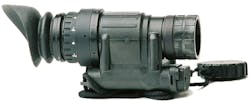Army asks Elbit to build legacy light-amplification monocular for night vision and degraded visibility
ABERDEEN PROVING GROUND, Md. – U.S. Army night vision experts needed monocular night vision devices for military operations at night and in degraded-visibility conditions. They found their solution from the Elbit Systems of America Night Vision segment in Roanoke, Va.
Officials of the Army Contracting Command at Aberdeen Proving Ground, Md., announced a $12.3 million contract to Elbit on Friday for AN/PVS-14 Monocular Night Vision Devices.
The legacy AN/PVS-14 night-vision monocular is in widespread use by the U.S. military and NATO allies. It uses a third-generation image intensifier tube, and often is used hands-free using a head harness or attached to a combat helmet. The AN/PVS-14 can double as a weapons night sight.
The Elbit F6015 is the company's version of the AN/PVS-14 night vision monocular. It enables soldiers to move rapidly and effectively in all night conditions without the need to carry several different types of specialized night-vision equipment.
The night-vision monocular is engineered for handheld, weapon-mounted, and camera-adapted use, and features a Gen 3 F9815 image intensifier tube with variable gain. Its dark-adapted, unaided-eye technology provides situational awareness and close-range vision.
The lightweight, single-battery monocular is being upgraded and replaced by more modern night-vision technologies. The AN-PVS-14 primarly uses light-amplification sensors, while the systems replacing it often combine light amplification and infrared sensor technologies.
On this contract Elbit will do the work t locations to be determined with each order, and should be finished by March 2025. For more information contact Elbit Systems of America Night Vision online at www.elbitamerica.com/night-vision, or the Army Contracting Command-Aberdeen Proving Ground at https://acc.army.mil/contractingcenters/acc-apg/.

John Keller | Editor-in-Chief
John Keller is the Editor-in-Chief, Military & Aerospace Electronics Magazine--provides extensive coverage and analysis of enabling electronics and optoelectronic technologies in military, space and commercial aviation applications. John has been a member of the Military & Aerospace Electronics staff since 1989 and chief editor since 1995.

